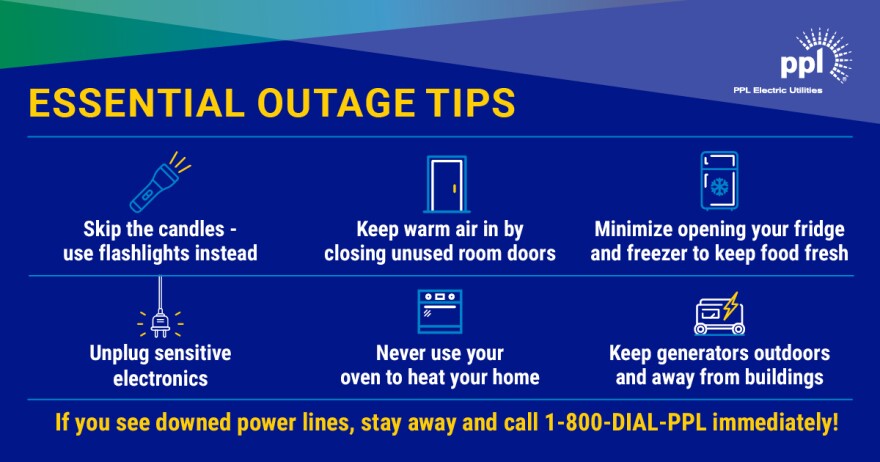BETHLEHEM, Pa. — As freezing temperatures and dangerous wind chills settle over Pennsylvania, the Red Cross issued tips to stay safe and PPL Electric Utilities tips to help customers navigate the extreme cold stretch.
The National Weather Service office in Mount Holly, New Jersey, in a three-day forecast Monday morning saw bitterly cold temperatures of as low as 14 degrees overnight into Tuesday.
A cold weather advisory remains in effect through noon Wednesday.National Weather Service-Mount Holly, New Jersey
Tuesday and Wednesday are expected to be even worse, with highs of only 23 degrees and overnight lows of 10 or 11 degrees.
Those temperatures are expected to be accompanied by "gusty" winds and areas of blowing and drifting snow.
A cold weather advisory remains in effect through noon Wednesday, with wind chills as low as 13 degrees below zero.
The Red Cross of Greater Pennsylvania urged people to stay warm indoors and, if your home becomes too cold, to go to a public library, shopping mall or warming center.
It also warned to use care with space heaters and fireplaces to prevent fires.
Anything that could catch fire should be kept at least 3 feet from the heat, and portable heaters should be turned off when you leave the room or go to sleep.
Cold, frostbite, hypothermia
The Red Cross also urged people to use battery-powered lights and flashlights instead of candles to prevent fires.
If you must go outside, wear layers of loose clothing, a coat, hat, mittens and water-resistant boots. Use a scarf to cover your face and mouth.
Check on loved ones and neighbors to make sure they are staying warm, particularly if they are older or live alone.
Your nose, ears, cheeks, chin, fingers and toes are often the first areas affected.American Red Cross
Be careful walking on snow or ice and avoid overexertion when shoveling snow. If possible, work with a partner and take frequent breaks.
Stay off the roads when possible. If you become stranded, stay in the vehicle and wait for help.
Stay warm to avoid frostbite and hypothermia. Your nose, ears, cheeks, chin, fingers and toes are often the first areas affected. Signs of frostbite include pain, numbness or a change in skin color.
Signs of hypothermia, which can be deadly, often include shivering, confusion, drowsiness and slurred speech.
Get out of the cold immediately if you see signs of hypothermia or frostbite, and get emergency medical care right away.
Staying safe
PPL Electric Utilities noted that colder temperatures can cause significantly higher demand for electricity.
It urged people to prepare an emergency kit, including non-perishable food, water, medication, first aid supplies and any pet supplies you may need, and to include batteries and battery-operated flashlights.
It also urged customers to use space heaters sparingly, and not to plug them into extension cords or power strips. Also, give them plenty of space and keep them on a level surface away from flammable objects and foot traffic.
Don’t leave these devices unattended or use them while you are sleeping.
If you must use a generator, use the proper fuel and only add fuel when the generator is cool. Generators should never be used in an enclosed area or placed inside a home or business.
Be sure to also keep them away from windows and vents that could let carbon monoxide sneak inside. Make sure your home has battery-operated carbon monoxide detectors in good, working condition.
Cutting power use
In the event of an outage, avoid using candles for lighting because they can start fires. Use flashlights instead.
Avoid opening your refrigerator and freezer as much as possible.
Do not use gas ovens or ranges to heat your home.
You can save up to 1% in heating costs for every degree you dial back your thermostat, according to the Department of Energy.PPL Electric Utilities
Cover drafty windows. Roll up a towel or blanket for the bottom of draft exterior doors. If possible, add caulking or weather stripping to seal air leaks around doors and windows.
Bundle up with extra blankets or clothes. You can save up to 1% in heating costs for every degree you dial back your thermostat, according to the Department of Energy.
Keep your fireplace damper closed unless a fire is burning. Having the damper open is like having a window wide open as it lets warm air escape through the chimney.
Letting the sun shine in through your windows during the day can keep your home warmer, which means using less energy. When the sun goes down, be sure to close the drapes to reduce heat loss through windows.


